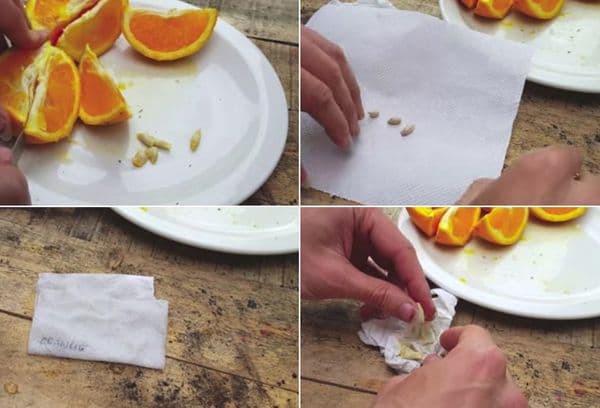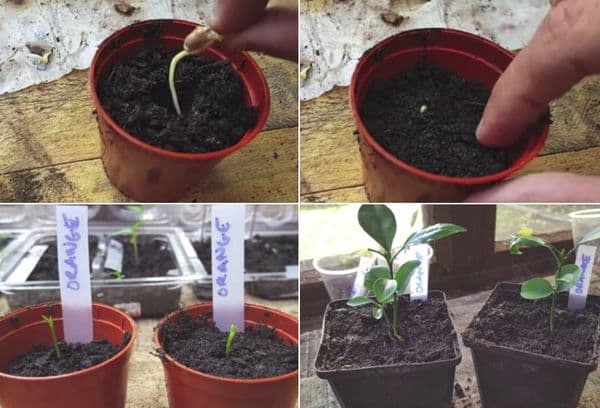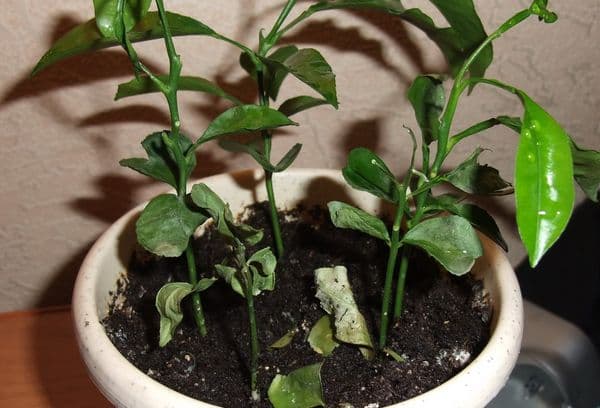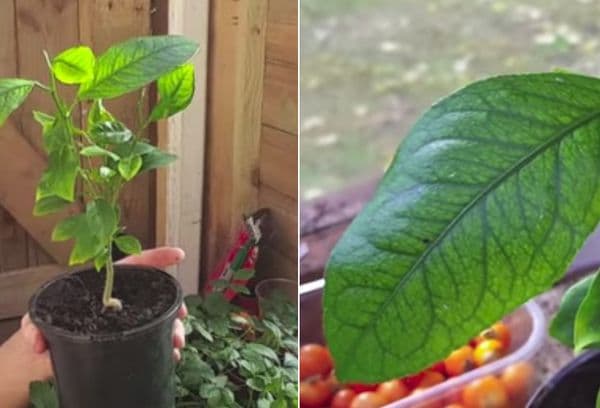How to germinate an orange seed: step-by-step instructions.
Everyone at least once in their life has had the idea of planting and germinating an orange seed (tangerine, lemon or any other) while eating an amazingly tasty citrus fruit. But many immediately abandoned this idea, fearing that nothing worthwhile would grow from the grain of a store-bought fruit. In reality, everything is much more optimistic. At home, you can germinate an orange seed, and the tree will delight you with juicy fruits.

Main difficulty
The favorable climate for orange is the tropics and subtropics (Italy, Brazil, China, India, etc.), and the microclimate of the apartment is not at all similar to the desired conditions. This is perhaps the main difficulty. However, the magazine purity-en.htgetrid.com clarifies: the problem is not the temperature, as most novice gardeners think, but poor lighting and incredibly dry air, to which the orange tree is very sensitive.
Poor conditions greatly inhibit development, the plant slows down three times. If in Italy a tree sprouted from the same orange seed (like many other citrus fruits) begins to bear fruit within 5-7 years, then in an apartment in central Russia the process drags on for 20-25 years. Waiting that long is not the best incentive for a gardener. Fortunately, there are effective ways to speed up the growth of an orange, and in very inexpensive ways and without much effort.
How to grow an orange tree from a seed
So, how can you germinate an orange seed in an apartment?
Preparatory steps:
- Even at the purchasing stage, you should give preference to the ripest fruits. By the way, their taste will be sweeter.
- The seeds must be carefully removed, being careful not to damage them. Some gardeners recommend rinsing them after removing them. This is especially important if you need to store the seeds for some time: this way they will not turn sour.
- If the kernels are lying around for the time being, they should not be allowed to dry out too much, otherwise they are unlikely to germinate.
- Seeds extracted from store-bought oranges do not last long. And the longer they lie, the more likely it is that they will “disappear.”
- For planting, it is worth taking the largest seeds without wasting energy on small ones: they are less viable.
- Before planting, you can soak them in a weak solution of vermicompost or sodium humate for an hour or two. Especially if they have been stored for some time and have had time to dry out. In any case, it is worth studying the instructions for each specific fertilizer before use. This will increase germination and help strengthen the sprouts in the future so that they can better survive difficult conditions.
Soil for orange
Most gardeners prefer store-bought soil whose name says “for citrus.” Forest soil (from under oak or aspen) or loose gray soil with garden soil (mixture proportions 1 to 1) is considered ideal.
Planting seeds:
- To begin with, a 100-200 gram pot, preferably with drainage holes, will be enough for orange seeds.
- It is better to sow from 3 to 10 pieces each, then select the most viable and strong ones.
- It should be planted to a depth of 1-2 cm, no more, and watered well. Resource ru He also advises covering the pot with cling film with holes made in it and placing it in a warm, bright place. This will create greenhouse conditions, which will speed up seed germination. As soon as the first shoots appear, the film must be removed and watered as needed, without damaging the sprouts with the stream.
- The seedlings must not be overcooled and care must be taken to ensure that they have enough light and moisture. Once every 2 weeks you can feed them with vermicompost or any other fertilizer in accordance with the instructions on the package.
- After 3-6 months, you can select the strongest seedlings and transplant them each into a separate larger pot. When picking, great care must be taken so as not to disturb the earthen ball and damage the root system.
- Having finished replanting, it is advisable to feed the seedlings with fertilizer again. It will help them adapt faster and not slow down their growth rate after suffering stress.
- Once every six months it is worth culling weak plants. Just by their appearance, it is quite easy to determine which of the future orange trees will begin to bear fruit faster: stocky ones with a dense crown, with short thorns or without thorns at all, rarely shedding their leaves. And a quick harvest cannot be expected from plants that often shed their leaves, with a large distance between the buds (in comparison with other representatives of the same species), with a large net of thorns and thin elongated shoots.
Lifehack from the author
Any seed store sells biodegradable molds with a tray - they are an excellent option for those who have never replanted plants and do not know how to do it.They help to transfer seedlings to a larger pot without damaging the root system and either decompose themselves from water and external factors, or are easily removed and do not disturb the earthen ball.
The above steps are relevant for almost any citrus fruit, except for particularly capricious ones. And if you have difficulties choosing from a huge assortment and are not sure that everything will work out, then the magazine purity-en.htgetrid.com and leading agronomists advise starting with tangerine. This plant is quite unpretentious in indoor conditions and will not cause any special problems. Next on the list are not capricious lemon and orange. But it’s better to refrain from planting a kumquat if you don’t have time to carefully care for it.
Formation
Another point worth knowing: the orange tree seedling must be shaped as it grows. Only the stem should not be allowed to develop. Lateral branching is fundamentally important.
Citrus fruits do not grow all the time, but in periods, 4-5 times a year with breaks of 1 to 3 months between them. This must be taken into account, tracked and pinched at the top of the shoot every second wave of growth. The same is done with the side branches after several leaves appear on them. In this way, you can achieve the desired bushiness of the tree and a pleasant appearance of the crown. The procedure will also prevent the orange from growing in height, which is unacceptable in an apartment.
It is also worth monitoring the appearance of individual vertically growing branches, bending or tying them to the trunk while they are still flexible.
Girding the trunk or main branches will help bring fruiting a little closer.It must be done very carefully: tie it with wire, slightly pressing the bark and leave it for no more than six months, otherwise the branch or the plant itself will begin to dry out and die. A hormonal surge will occur in these places, which will help accelerate the formation of fruit buds.
With proper care and attention, an orange tree in indoor conditions is quite capable of producing its first fruits within 5 years, and for this there is absolutely no need to frantically look for cuttings to graft the plant. Few people in the world graft citrus fruits this way. And caring for it is not as difficult as many people think. But the advantages are obvious: even before the orange begins to bear fruit, it will fill the air in the apartment with a pleasant aroma, which, by the way, will help during periods of colds and flu, since it has bactericidal properties. And without a doubt, a neat tree will decorate any interior.




